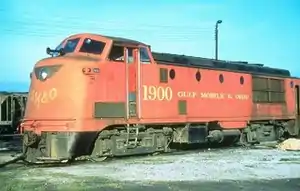Ingalls 4-S
The Ingalls 4-S was an experimental American locomotive built by Ingalls Shipbuilding immediately after World War II. Intended as the first of many Ingalls-built locomotives, it was the only one the company built. It served on the Gulf, Mobile and Ohio Railroad (GM&O) until it was retired in 1966; it was scrapped the following year.
| Ingalls 4-S | |||||||||||||||||||||||||||||||||||||||||||
|---|---|---|---|---|---|---|---|---|---|---|---|---|---|---|---|---|---|---|---|---|---|---|---|---|---|---|---|---|---|---|---|---|---|---|---|---|---|---|---|---|---|---|---|
 | |||||||||||||||||||||||||||||||||||||||||||
| |||||||||||||||||||||||||||||||||||||||||||
| |||||||||||||||||||||||||||||||||||||||||||
| |||||||||||||||||||||||||||||||||||||||||||
| |||||||||||||||||||||||||||||||||||||||||||
Design and development
At the end of World War II, Ingalls Shipbuilding, based in Pascagoula, Mississippi, developed plans for a line of diesel-electric locomotives to serve the expected post-war market. Five models were projected; the first, and as it proved only, to be built was a prototype of the largest, the model 4-S.[1]
A single demonstrator was planned in December 1945, and built in March 1946, numbered #1500. The design of the locomotive was considered advanced, including a "turret cab" arrangement, which improved the crew's vision.[2] The prime mover selected for the locomotive was the inline-8 65LX8, based on a marine diesel engine built by Superior Engines & Compressors; and modified for railroad use by Cooper-Bessemer, and Elliott Company providing the turbocharger. The 4-S produced 1,650 hp (1,230 kW), of which 1,510 hp (1,130 kW) was available for the production of tractive effort by the locomotive's electric drive, but marketed as 1,500 horsepower.[1] Provision was made for the installation of a steam generator for passenger service.[2] The locomotive was equipped with connections for multiple unit operation.[3]
Operational service
The 4-S demonstrator was tested by a number of railroads, including the Louisville and Nashville, Seaboard Air Line, Mississippi Export Railroad, Gulf, Mobile and Ohio, and the Southern Railway; however no orders materialized for the type, or for any other of Ingalls' proposed locomotives.[2] The lack of orders combined with issues with the supply of components resulted in Ingalls electing to abandon its plans for locomotive construction;[1] the sole 4-S was the only locomotive they ever built.[4] It was sold to the Gulf, Mobile and Ohio Railroad for US$140,000 in June 1946, where it received the road number 1900.[2]
The 4-S served with the GM&O, operating primarily from Mobile, Alabama, to Jackson, Mississippi, but also served around Meridian and Laurel. It was used in switching duty, earning a reputation for toughness;[1] it once derailed, landing inverted, but was repaired and returned to service in short order.[2] In 1966, the railroad traded it in to EMD as partial payment for new SD40s.[1] It was offered to the Illinois Railway Museum for US$3,000, but the museum was unable to raise the funds.[2] When no other buyers materialized,[1] it was sold to Pielet Brothers in 1967, where it was scrapped.[2]
References
- GM&O Historical Society News, Issue #42, 1986. Via National Model Railroad Association, Pacific Coast Region. Retrieved 2012-01-17.
- Anderson, Joanne (June 5, 2011). "Ingalls-built locomotive served for 21 years". The Mississippi Press. Pascagoula, Mississippi. Retrieved 2012-01-17.
- "The Ingalls 1500-HP. Diesel-Electric Locomotive". Diesel Power, Volume 24, 1946. Pages 588-589, 614
- Schramm, Jeffrey W. (2010). Out of Steam: Dieselization and American Railroads, 1920-1960. Cranbury, New Jersey: Associated University Press. p. 304. ISBN 978-0-9821313-7-4.
5. ^ Rutherford , R. C. (2013). Ingalls Shipbuilding (1949). The Diesel Shop. Retrieved November 9, 2022, from https://www.thedieselshop.us/Ingalls_Flyer.pdf